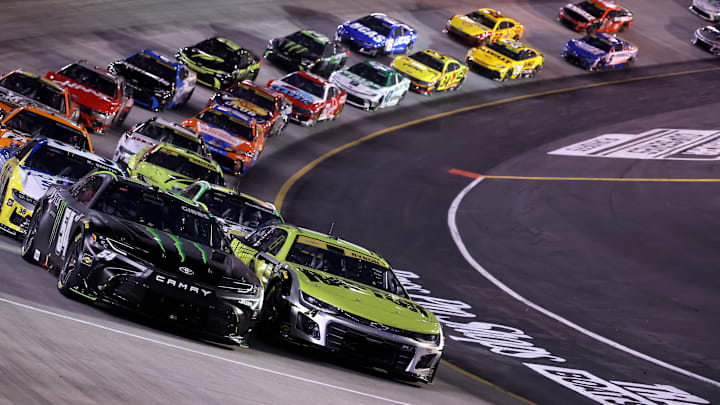The NASCAR Cup Series closed out the round of 16 of the playoffs on Saturday night at Bristol Motor Speedway, with Christopher Bell outlasting the field to complete a first-round sweep for Joe Gibbs Racing.
A new right-side tire was introduced by Goodyear with the goal of producing more wear, and drivers and teams were unsure of what to expect after experiencing hardly any wear or degradation at all in practice on Friday.
Only 25 laps into the race, it became apparent that tire wear was going to resemble the 2024 spring race at Bristol. Polesitter A.J. Allmendinger hit pit road with a right-side tire issue, and that set the stage for a chaotic race that saw the third-most lead changes in Bristol's history (36) and a season-high 14 cautions as drivers balanced managing their tires while trying to maintain track position.
Rudy Fugle, two-time Daytona 500-winning crew chief with William Byron, was on SiriusXM NASCAR Radio Monday morning. While he did not entirely place the blame on Goodyear for the way the race played out on Saturday night, Fugle wants the industry to arrive at a goal, specifically at Bristol.
"Somebody has to put the goal on the wall. What do we want the Bristol race to be?" Fugle said. "If you don't know what that goal is, we don't know what we're trying to achieve. ... We don't even know what the goal is, so once we determine what the goal is and make somebody happy, then we'll try to go fight it, but I don't even know what we're trying to achieve."
🗣️ "I don't even know what the goal is [...] I don't even know what we're trying to achieve."@TeamHendrick Crew Chief Rudy Fugle shared his thoughts on the @GoodyearRacing tire wear at @ItsBristolBaby over the weekend.
— SiriusXM NASCAR Radio (Ch. 90) (@SiriusXMNASCAR) September 15, 2025
More from #TMDNASCAR → https://t.co/MKhd9eLpQA pic.twitter.com/OydiR9p9LL
NASCAR drivers have been asking for more tire wear
While the tire wear may have been more than most drivers had bargained for Saturday night, it was more in line with what they have been asking for, especially compared to the spring race that hardly featured any passing, only had three cautions, and saw Kyle Larson completely dominate.
According to NASCAR Insights, the Bristol Night Race had 137 caution laps, which were the most in any Cup Series race in the Modern Era (1,771 races), so the attrition was palpable from the drop of the green flag.
Christopher Bell wins at Bristol, Joe Gibbs Racing's 11th of the season, their most since 2019.
— NASCAR Insights (@NASCARInsights) September 14, 2025
The race saw 137 laps of cautions, the most in ANY Cup Series race in the Modern Era (1,771 races). pic.twitter.com/LxBNE3k0NK
However, it was not like drivers were cutting tires to bring out the cautions. The cars were just simply a handful to drive, and aggressiveness was at an all-time high, with several drivers facing playoff elimination.
Despite the tire fall-off, the battle at the cut line was as intriguing as it could get in the closing laps as Alex Bowman tried to win his way into the next round.
Although Chase Elliott clearly thought his playoff hopes were over following a hard impact with the outside wall with 190 laps to go, he advanced, meaning that it was Cindric, whom many believe started the round with "no chance" to advance, whom Bowman could bump out, but he failed to do so.
It was arguably the most entertaining playoff cutoff race at Bristol yet, even if the tire wear was excessive. It still produced some drama around the cut line and forced drivers to manage their tires or risk losing track position.
With no ability to make the top line work, drivers had to maneuver around the bottom and use their bumper to make passes, a nod to how the racing used to be at "Thunder Valley".
By no means was the aggressive tire fall-off anything like Bristol used to feature, but it challenged NASCAR's best to save their tires and gave them a chance to pass when they previously have not been able to do so at Bristol and at most other short tracks.
Although the cooler conditions seemed to play a role, tire wear was brought back into the conversation on Saturday night. The question now goes back to what Fugle alluded to, which is, "what do we want the Bristol race to be?"
If we want racing to fully resemble what it used to look like there, introducing so much tire wear is not the entire answer, because drivers could not go full throttle for an entire run on Saturday night. However, if we want tires to play a role and still keep the racing around the bottom, that is exactly what we got this time around.
It may not have been the most enjoyable race for some, but for those who were upset with the lack of passing and tire fall-off in 2024's Bristol playoff race and in the spring, this was certainly a step in the right direction, even if there were fewer green flag laps in the process.
